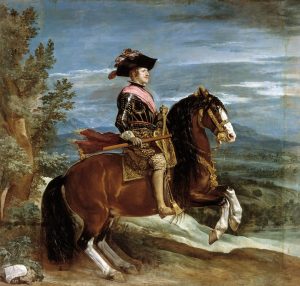The second royal portrait is the equestrian sculpture of Philip IV, signed by Pietro Tacca, a Florentine artist, well-known by the learned courtiers of Cosimo III. In the History of Art, this work stands out for having been the first one to adopt the position in “corvette”, technically almost impossible to achieve in sculpture. The young Duke and his “comrades” could still admire it in its original location, in the Buen Retiro gardens. This is how Magalotti describes it: “In the middle of the courtyard there is a bronze horse, Pietro Tacca’s work, which stands with a noble attitude only on its hind legs, on top of a white marble pedestal, majestically mounted by the statue of Philip IV, to whom was given by His Serene Highness the Grand Duke Ferdinand II”

Apparently, the dynamic posture of the horse was a requirement of King Philip, who sent to Florence the equestrian portrait painted by Velázquez, currently preserved in the Uffizi.

Velázquez, in turn, asked his friend Martínez Montañés to make a bust of the king, in order to send it also to Florence and make easier the work of Pietro Tacca. As a token of gratitude, Velázquez painted the magnificent portrait of Martínez Montañés, in which he appears in the act of modeling such bust. Besides, it was still necessary the involvement of another genius, scientist in this case, to meet the demand of the king: the famous Galileo, protected by Grand Duke Ferdinand, suggested to Pietro Tacca the way to balance the weight of the sculpture, making solid the hindquarters of the horse. Once more we can say about King Philip IV, questionable maybe as a politician, but infallible as a “connoisseur”, that never was a monarch “of talents better served”.

